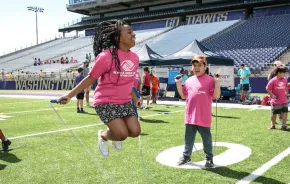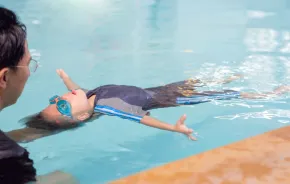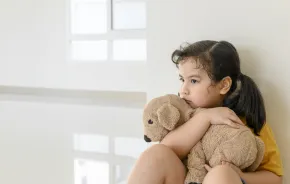 When our kids were still in their single digits, our family travel was consumed with basic survival issues, such as eating and sleeping. Now that our children, Andy and Jackie, our older, the big challenges are making our trips educational and fun. Our kids are at the age when traveling with Mom and Dad isn’t cool, friends at home are the preferred vacation partners and being told to “get in the car, we’re going on an airplane today” no longer works.
When our kids were still in their single digits, our family travel was consumed with basic survival issues, such as eating and sleeping. Now that our children, Andy and Jackie, our older, the big challenges are making our trips educational and fun. Our kids are at the age when traveling with Mom and Dad isn’t cool, friends at home are the preferred vacation partners and being told to “get in the car, we’re going on an airplane today” no longer works.
Get them involved
High schoolers and college students feel that summer break is a vacation they’ve earned. If this European trip is not their trip, then you become the enemy. Ask for their help. Even kids can get excited about a vacation if they’re involved in the planning stages. Consider your child’s suggestions and make real concessions. “Europe’s greatest collection of white-knuckle rides” in Blackpool might be more fun than another ruined abbey. Remember to take it easy at the beginning of your trip, allowing a couple of low-impact days to get over jet lag.
Pre-trip study helps get children tuned into and prepared for upcoming experiences. Read books such as The Diary of Anne Frank for Amsterdam. Watch movies together such as The Sound of Music for Salzburg, and Brother Sun, Sister Moon for Assisi. Get a jump on the phrases, learning the top 20 or so before you leave home.
Since a trip is a splurge for the parents, the kids should enjoy a larger allowance, too. Provide ample money and ask your kids to buy their own treats, gelati, batteries and trinkets within that daily budget. In exchange for the extra allowance, require them to keep a daily journal or scrapbook.
Help your kids collect and process their observations. Bring tape, a glue stick and scissors (in your checked baggage) from home. But if you buy the actual journal at your first stop, it becomes a fun souvenir in itself. Kids like cool books — pay for a nice one. The journal is important, and it should feel that way. Encourage the kids to record more than just a trip log; collect feelings, smells, reactions to cultural differences and so on.
With older kids, Mom and Dad have much more freedom. Kids can go to the breakfast room early or late. If they don’t want to go out for the evening, they can stay in the hotel. Nearly all rooms have TVs (although you have to be careful — many have pornography channels). To pass the time, our kids each pack a handheld video game and an MP3 player.
Planning your day
Review the day’s plan at breakfast. It should always include a kid-friendly activity. Hands-on tours, from cheese-making to chocolate factories, keep kids engaged. Go to sports or cultural events, but don’t insist on staying for the entire event.
Kids need plenty of exercise. Allow time for a few extra runs on the luge. Small towns often have great public swimming pools. And mountain bikes are easily rentable (with helmets), suddenly making the Alps cool.
Make the consequences of packing heavy perfectly clear: They carry all their stuff all the time. Help your kids pack layers for warmth, clothes that don’t show dirt, and sturdy, well-broken-in shoes. Each person should have a day bag for ready access in the car (it keeps down clutter). Make the car trunk a pantry of snacks, water and picnic items.
While the train is workable with older kids, we still prefer family vacations by car. With a car, we enjoy doorstep-to-doorstep service with our luggage and can be a little bolder about coming into town without a reserved room. I delegate navigating responsibilities to our kids. Following a map to help Dad drive through a new town or leading the family back to the hotel on the Paris Métro is a great confidence builder.
In a crowded situation, having a unique family noise (a whistle or call, such as a “woo-woop” sound) enables you to easily get each other’s attention. Consider buying cheap walkie-talkies in Europe to help you relax when the kids roam. (Don’t bring them from home, as ours use a different bandwidth and are illegal in Europe.) Older children can wear money belts with photocopies of their passport and hotel information.
Most hotels have large family rooms. You need to know the necessary phrases to communicate your needs. When our children were younger, we requested a triple room plus a small extra child’s bed. Now we get two rooms for our family of four: A double (one big bed) and a twin (a room with two single beds). In much of Europe, a “double” bed is actually two twins put together. These can easily be separated.
Families can stay in hostels very cheaply. Family membership cards are inexpensive, and there’s no age limit except a maximum of 26 in Bavaria (waived for adults traveling with their children). Many hostels have “members’ kitchens” where the family can cook and eat for the price of groceries.
Living on the road far from their favorite TV shows and neighborhood friends has broadened our children’s outlook. They’ve learned what all travelers know: The size of your backyard is up to you.
Rick Steves has taught smart European travel for 30 years. He is the author of numerous guidebooks, including the best-selling Europe Through the Back Door, and hosts a TV series and radio program. He and his wife, Anne, live in Edmonds. Visit his website at ricksteves.com.
Rick Steves’ kids vote on Britain’s best and worst activities
Imagine being a teenager forced to spend a big part of your summer vacation with that 40-something robo-tourist, Rick Steves (alias Dad). Jackie and Andy did just that, and yes, they’re glad to be home. What were the highlights? Here are the results of our family’s post-trip interview:
Best city: Blackpool — England's white-knuckle ride capital! The Pepsi Max Big One (one of the world’s fastest and highest roller coasters) is still the best. A tip: Avoid the old wooden-framed rides. They’re too jerky for parents.
Best nature experience: A horse ride through the Cotswolds (around $30 per hour with a guide who’ll teach you to trot). But wear long pants. One hour is plenty.
Guided tours: Open-deck bus tours are good for picnic lunches with a moving view. Audioguide tours (now available at most sights) are nice because you can pick and choose what you want to learn about.
Fun museums: Camera Obscura, Edinburgh’s primitive 1830s spy camera from a tower. It comes with a funny demonstration and three floors of fun illusions and early 3-D photographs. Warwick Castle, with Madame Tussaud’s wax people having a garden party in 1900.
Worst food: The “black pudding” that so many B&B people want you to try for breakfast ... it’s a gooey sausage made of curdled blood.
Best new food: Chocolate-covered digestive biscuits and vinegar on chips (that’s British for French fries).
Most boring tour: The Beatles tour in Liverpool — most kids couldn’t care less about where Paul McCartney went to grade school or a place called Strawberry Fields.
Funniest activity: Bizarre Bath’s walking tour is two hours of jokes and not a bit of history. It’s irreverent and dirty — but in a way that parents think is OK.
Best activities: Leisure (LEZH-ur) Centres in almost every town have good swimming pools. Some B&Bs have video libraries, and others have VCRs and a video-rental place nearby that rents to guests of that B&B. Checking e-mail and surfing the web at Internet cafés — London’s easy Internet café is huge, cheap and fast.
Best theater: Shakespeare’s Globe. First, tour the theater to learn about how and why it was built like the original from 1600. Then buy cheap ($9) “groundling” tickets to see the actual play right up front, with your elbows on the stage. The actors involve the audience ... especially the groundlings.
Most interesting demonstrations: The precision slate-splitting demonstration at the slate mines in north Wales; the medieval knight at the Tower of London who explained his armor and then demonstrated medieval sword-fighting tactics — nearly killing his squire.









